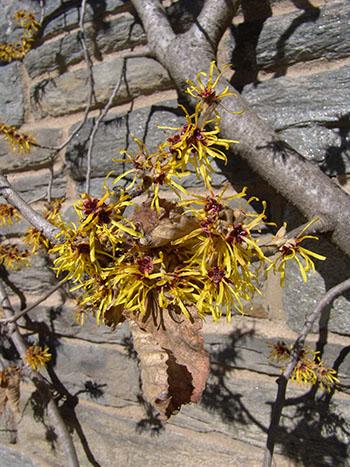Plants of the Week: March 9
Betula nigra Heritage® ‘Cully’
One plant that really shines in the winter is the river birch. Though it is an incredibly messy tree, dropping twigs and shedding bark year round, it is an especially interesting textural accent to the winter garden. The whole of the tree is covered with orange-brownish bark which peels to reveal its white inner bark. The coloration is reminiscent of the white-bark birch species. photo credit: J. Bickel
Hamamelis mollis ‘Early Bright’
Swarthmore College, with its buildings and structures, has many interesting microclimates. South-facing building edges are good for capturing what little dry heat is available during winter. These little warm spots are often home to some of the more precocious, showy flowering plants.
One such microclimate exists in the Theresa Lang Garden of Fragrance on the south-facing wall of Clothier Hall. It is protected from wind on all sides and supports an early blooming, finely espaliered H. mollis ‘Early Bright’. This particular setting traps the fragrance that emanates from the bright-yellow and deep-burgundy flowers, drawing the attention and beckoning spring. photo credit: R. Robert
Mahonia japonica
Mahonia japonica has evergreen foliage that provides greenery and texture during the winter months. The Mahonia japonica planted in the Winter Garden, however, caught my attention because of its seeming defiance of the evergreen nature oft seen in this species. sitting with its partner, both are completely flame-orange and red, popping brightly against the drab, mulched hillside (soon to be rife with winter aconite) bringing a little extra flash of color as winter draws to a close. photo credit: J. Bickel





![Betula nigra Heritage 'Cully' JTB [3]](https://www.scottarboretum.org/wp-content/uploads/2015/03/Betula-nigra-Heritage-Cully-JTB-3.jpg)

![Mahonia japonica JTB [5]](https://www.scottarboretum.org/wp-content/uploads/2015/03/Mahonia-japonica-JTB-5.jpg)
No Comments